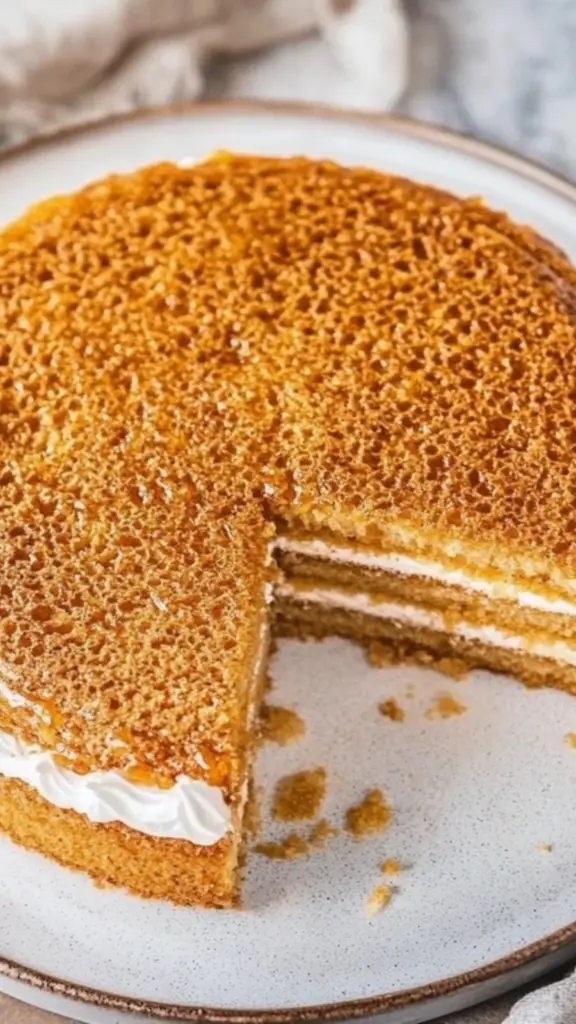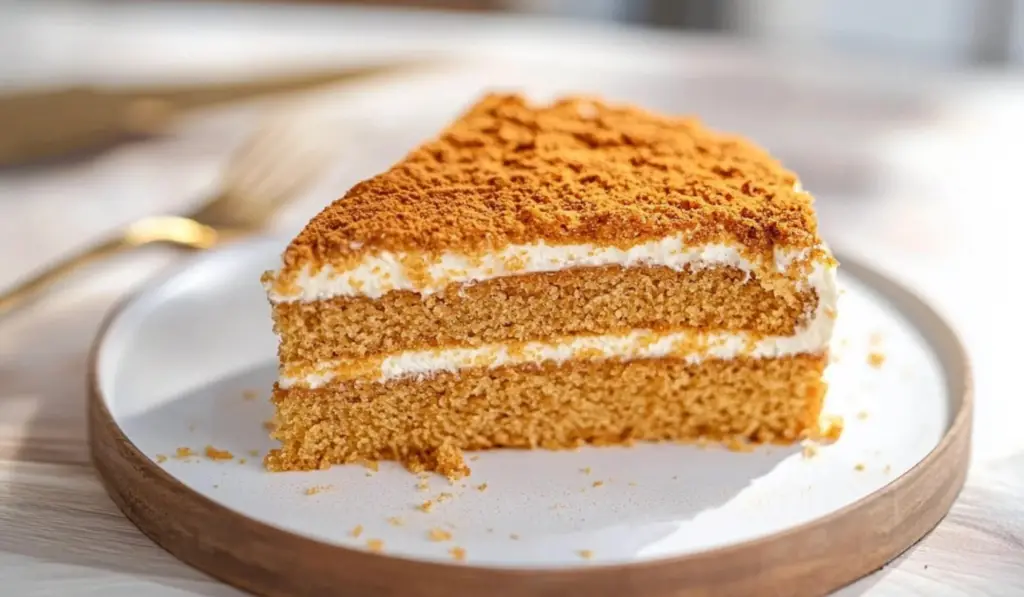When it comes to Eastern European desserts, Russian Honey Cake (Medovik) stands out as a true classic. Its roots trace back to Russia, where it has been a staple dessert for generations. With its rich layers of honey-sweetened sponge cake, complemented by a luscious sour cream frosting, Medovik offers a deliciously unique flavor experience. The combination of sweet, tangy, and creamy elements, along with the cake’s delicate, spongy texture, makes it an irresistible dessert for any occasion.
PrintRussian Honey Cake Recipe (Medovik): A Timeless Delight for Dessert Lovers
When it comes to Eastern European desserts, Russian Honey Cake (Medovik) stands out as a true classic. Its roots trace back to Russia, where it has been a staple dessert for generations. With its rich layers of honey-sweetened sponge cake, complemented by a luscious sour cream frosting, Medovik offers a deliciously unique flavor experience. The combination of sweet, tangy, and creamy elements, along with the cake’s delicate, spongy texture, makes it an irresistible dessert for any occasion.
- Prep Time: 45 minutes
- Cook Time: 30 minutes
- Total Time: 1 hour 15 minutes
- Yield: 16 slices 1x
- Category: Dessert, Cake, Sweet Treat, Eastern European Dessert
- Method: Baking, Layering
- Cuisine: Russian, Eastern European
- Diet: Vegetarian
Ingredients
Sponge Cake:
- 3 eggs: The eggs provide structure to the cake and help bind the ingredients together. They also contribute to the cake’s light and airy texture.
- 1 cup clover honey: Honey is the star ingredient of this cake, giving it a natural sweetness and a distinct flavor. It also adds moisture to the sponge cake, ensuring it remains soft.
- 2 cups all-purpose flour: The flour serves as the base of the sponge cake, providing structure and stability to each layer. Use a high-quality all-purpose flour for the best results.
- 2 tsp baking soda: The baking soda helps the cake rise, giving it a light and fluffy texture.
- 1 tbsp white distilled vinegar: When combined with the baking soda, the vinegar creates a chemical reaction that helps the cake layers rise and become tender. It also balances the sweetness of the honey.
Sour Cream Frosting:
- 8 oz Cool Whip (thawed): Cool Whip adds lightness and fluff to the frosting. It helps create a soft, airy texture that contrasts nicely with the dense cake layers.
- 1 cup sour cream: Sour cream provides a tangy, creamy element to the frosting, balancing the sweetness of the honey cake and enhancing the flavor.
Instructions
Step 1: Preheat the Oven and Prepare the Baking Sheet
Start by preheating your oven to 350°F (175°C). To prepare for baking, invert the 18×13″ baking sheet and line it with four pieces of parchment paper. The overhanging parchment paper will make it easier to remove the cake layers once they’re baked. Ensure that the paper extends slightly beyond the edges of the baking sheet so that you have enough to lift the cake out later.
Step 2: Make the Sponge Cake Batter
In a large mixing bowl, beat together the eggs and honey for about 2 minutes until the mixture is smooth and well combined. The honey will not only provide sweetness but also help give the cake its characteristic golden color. In a separate bowl, mix the baking soda with the vinegar. This mixture will bubble up, creating a chemical reaction that helps the cake rise.
Add the baking soda and vinegar mixture to the egg and honey blend, then gradually incorporate the flour. Stir gently until you have a smooth, lump-free batter. Be careful not to overmix, as this can affect the texture of the cake.
Step 3: Bake the Cake Layers
Once your batter is ready, measure out ½ cup of the batter and spread it as thinly as possible over the prepared baking sheet. Be sure to cover the entire surface, reaching all the corners of the baking sheet. The key to Medovik is having thin layers of cake, so take your time to spread the batter evenly.
Bake the first layer for 7 minutes, then remove it from the oven and allow it to cool slightly. Repeat the process for the remaining three layers, baking each for around 7 minutes. This will result in four thin, golden-brown cake layers.
Step 4: Cool the Cake Layers
Once the layers are baked, allow them to cool completely. Cooling the layers before removing the parchment paper is crucial to prevent the cake from tearing. After the layers have cooled, carefully peel off the parchment paper. Using a 7-8″ plate, cut two circles from each layer to create a total of eight layers. Reserve the leftover cake scraps.
Step 5: Prepare the Cake Crumbs
Place the leftover cake scraps onto a separate baking sheet and bake them at 275°F (135°C) for 5-8 minutes, allowing them to dry out. Once the scraps have dried, transfer them into a zip-lock bag and crush them with a rolling pin until finely ground. These crumbs will be used to decorate the finished cake, adding both texture and visual appeal.
Step 6: Make the Sour Cream Frosting
In a mixing bowl, combine the Cool Whip and sour cream. Stir until the mixture is smooth and well-blended. The sour cream gives the frosting a tangy richness that balances the sweetness of the honey cake, while the Cool Whip adds lightness and fluff. The frosting should have a soft, spreadable consistency. If it’s too thick, you can add a tablespoon of sour cream to loosen it up.
Step 7: Assemble the Cake
Place one of the cake layers onto your serving plate. Spread a generous amount of sour cream frosting over the top, making sure to cover the entire surface. Repeat this process for each layer, frosting between each one. Once all the layers are stacked, use the remaining frosting to cover the top and sides of the cake. After frosting, take the crushed cake crumbs and sprinkle them generously over the top and sides. These crumbs add both flavor and texture to the cake, making it even more delicious.
Step 8: Chill and Serve
To allow the flavors to meld and the cake layers to soften, refrigerate the Medovik for at least 1 hour, though overnight is ideal. The resting time helps the frosting soak into the cake layers, resulting in a tender, flavorful dessert. When you’re ready to serve, slice the cake into portions and enjoy!
Notes
- Honey Variations: Feel free to experiment with different types of honey, such as wildflower honey, orange blossom honey, or buckwheat honey. Each variety will impart a unique flavor to the cake.
- Sour Cream Substitution: If you prefer a lighter frosting, you can substitute Greek yogurt for the sour cream. Greek yogurt will provide a tangy flavor but with a slightly thicker texture.
- Frosting Adjustments: If you find that your frosting is too thick, you can add a bit of milk or heavy cream to loosen it up. This will help the frosting spread more easily.
- Additional Flavorings: Consider adding vanilla extract or a pinch of cinnamon to the frosting for extra depth of flavor.
In Russia and many other Eastern European countries, Medovik is often served at celebrations and special gatherings. The cake’s beauty lies not just in its flavor but in its elegant presentation. The thin layers of cake, stacked high and covered in frosting, are often sprinkled with crushed cake crumbs, creating a beautiful and rustic appearance. Medovik is a perfect dessert for impressing guests or simply enjoying a treat with family and friends.
This article will guide you through the process of making Russian Honey Cake, from the ingredients you’ll need to the step-by-step instructions for crafting this delicate dessert. Along the way, we’ll also highlight tips, variations, and helpful substitutions that will make it easier for you to prepare Medovik in your own kitchen. By the end of this article, you’ll have all the knowledge and inspiration to create a stunning, delicious Medovik that is sure to become a favorite in your baking repertoire.
A Look at the History of Medovik
Medovik’s history is steeped in tradition, and it’s often regarded as one of the most iconic desserts in Russian cuisine. The name “Medovik” comes from the Russian word for honey, “med,” which plays a central role in this dessert. Honey was a valuable ingredient in traditional Russian cooking, prized for its sweetness and its ability to preserve foods. Medovik’s combination of honey in the cake layers and a creamy, tangy frosting makes it a true representation of Russian dessert craftsmanship.
In its earliest forms, Medovik was a simple honey cake made with just a few ingredients: honey, flour, eggs, and sugar. Over the centuries, the recipe evolved, with different regions of Russia putting their unique spin on it. Today, Medovik is typically made with a sour cream frosting, which adds a creamy tang to balance the sweetness of the honey and creates the signature moist texture that makes this cake so irresistible.
Medovik is often prepared for holidays and family gatherings in Russia. Its popularity spread beyond Russia to other Slavic countries, and it has become a beloved dessert in many parts of Eastern Europe. Whether it’s served at a wedding, a birthday celebration, or just a family dinner, Medovik is a symbol of hospitality and generosity.
The Appeal of Medovik
What makes Medovik so special is the way it balances textures and flavors. The layers of sponge cake are light and airy, almost like a delicate honey-flavored cloud. These thin layers are then generously layered with a smooth and creamy frosting, creating a perfect contrast between the spongy cake and the rich, velvety cream. The cake crumbs that top the cake not only add a lovely rustic appearance but also give a satisfying crunch, enhancing the overall texture of the dessert.
The flavor profile of Medovik is another key factor that contributes to its widespread appeal. The honey provides a natural sweetness that isn’t overpowering, while the sour cream frosting adds a tangy richness that balances the cake’s flavor. It’s a sweet and savory combination that leaves a lasting impression on your taste buds. Medovik is also versatile – it’s just as delicious served at a formal dinner party as it is at a casual family gathering.
Beyond its delightful taste and texture, Medovik is a cake that requires a little patience and attention to detail, making it a fun project for home bakers. The process of baking each thin layer of sponge cake, assembling the layers, and preparing the frosting is both rewarding and therapeutic. The result is a cake that’s not just delicious but also a work of art.
Ingredients Breakdown
Before we dive into the process of making this delicious cake, let’s take a closer look at the ingredients you’ll need. Medovik is a relatively simple cake to make, but each ingredient plays a crucial role in achieving the perfect texture and flavor.
Sponge Cake:
- 3 eggs: The eggs provide structure to the cake and help bind the ingredients together. They also contribute to the cake’s light and airy texture.
- 1 cup clover honey: Honey is the star ingredient of this cake, giving it a natural sweetness and a distinct flavor. It also adds moisture to the sponge cake, ensuring it remains soft.
- 2 cups all-purpose flour: The flour serves as the base of the sponge cake, providing structure and stability to each layer. Use a high-quality all-purpose flour for the best results.
- 2 tsp baking soda: The baking soda helps the cake rise, giving it a light and fluffy texture.
- 1 tbsp white distilled vinegar: When combined with the baking soda, the vinegar creates a chemical reaction that helps the cake layers rise and become tender. It also balances the sweetness of the honey.
Sour Cream Frosting:
- 8 oz Cool Whip (thawed): Cool Whip adds lightness and fluff to the frosting. It helps create a soft, airy texture that contrasts nicely with the dense cake layers.
- 1 cup sour cream: Sour cream provides a tangy, creamy element to the frosting, balancing the sweetness of the honey cake and enhancing the flavor.
Step-by-Step Instructions
Step 1: Preheat the Oven and Prepare the Baking Sheet
Start by preheating your oven to 350°F (175°C). To prepare for baking, invert the 18×13″ baking sheet and line it with four pieces of parchment paper. The overhanging parchment paper will make it easier to remove the cake layers once they’re baked. Ensure that the paper extends slightly beyond the edges of the baking sheet so that you have enough to lift the cake out later.
Step 2: Make the Sponge Cake Batter
In a large mixing bowl, beat together the eggs and honey for about 2 minutes until the mixture is smooth and well combined. The honey will not only provide sweetness but also help give the cake its characteristic golden color. In a separate bowl, mix the baking soda with the vinegar. This mixture will bubble up, creating a chemical reaction that helps the cake rise.
Add the baking soda and vinegar mixture to the egg and honey blend, then gradually incorporate the flour. Stir gently until you have a smooth, lump-free batter. Be careful not to overmix, as this can affect the texture of the cake.
Step 3: Bake the Cake Layers
Once your batter is ready, measure out ½ cup of the batter and spread it as thinly as possible over the prepared baking sheet. Be sure to cover the entire surface, reaching all the corners of the baking sheet. The key to Medovik is having thin layers of cake, so take your time to spread the batter evenly.
Bake the first layer for 7 minutes, then remove it from the oven and allow it to cool slightly. Repeat the process for the remaining three layers, baking each for around 7 minutes. This will result in four thin, golden-brown cake layers.
Step 4: Cool the Cake Layers
Once the layers are baked, allow them to cool completely. Cooling the layers before removing the parchment paper is crucial to prevent the cake from tearing. After the layers have cooled, carefully peel off the parchment paper. Using a 7-8″ plate, cut two circles from each layer to create a total of eight layers. Reserve the leftover cake scraps.
Step 5: Prepare the Cake Crumbs
Place the leftover cake scraps onto a separate baking sheet and bake them at 275°F (135°C) for 5-8 minutes, allowing them to dry out. Once the scraps have dried, transfer them into a zip-lock bag and crush them with a rolling pin until finely ground. These crumbs will be used to decorate the finished cake, adding both texture and visual appeal.
Step 6: Make the Sour Cream Frosting
In a mixing bowl, combine the Cool Whip and sour cream. Stir until the mixture is smooth and well-blended. The sour cream gives the frosting a tangy richness that balances the sweetness of the honey cake, while the Cool Whip adds lightness and fluff. The frosting should have a soft, spreadable consistency. If it’s too thick, you can add a tablespoon of sour cream to loosen it up.
Step 7: Assemble the Cake
Place one of the cake layers onto your serving plate. Spread a generous amount of sour cream frosting over the top, making sure to cover the entire surface. Repeat this process for each layer, frosting between each one. Once all the layers are stacked, use the remaining frosting to cover the top and sides of the cake. After frosting, take the crushed cake crumbs and sprinkle them generously over the top and sides. These crumbs add both flavor and texture to the cake, making it even more delicious.
Step 8: Chill and Serve
To allow the flavors to meld and the cake layers to soften, refrigerate the Medovik for at least 1 hour, though overnight is ideal. The resting time helps the frosting soak into the cake layers, resulting in a tender, flavorful dessert. When you’re ready to serve, slice the cake into portions and enjoy!
Tips for Variations and Substitutions
- Honey Variations: Feel free to experiment with different types of honey, such as wildflower honey, orange blossom honey, or buckwheat honey. Each variety will impart a unique flavor to the cake.
- Sour Cream Substitution: If you prefer a lighter frosting, you can substitute Greek yogurt for the sour cream. Greek yogurt will provide a tangy flavor but with a slightly thicker texture.
- Frosting Adjustments: If you find that your frosting is too thick, you can add a bit of milk or heavy cream to loosen it up. This will help the frosting spread more easily.
- Additional Flavorings: Consider adding vanilla extract or a pinch of cinnamon to the frosting for extra depth of flavor.
Serving Suggestions
Medovik is a versatile cake that pairs well with various beverages. It’s perfect when served with a hot cup of tea, coffee, or even a glass of dessert wine. For a more festive touch, you can garnish the cake with fresh berries or a light dusting of powdered sugar. The cake also pairs beautifully with a scoop of vanilla ice cream or a drizzle of extra honey for added sweetness.

Final Thoughts
Russian Honey Cake (Medovik) is a dessert that truly embodies the beauty of Eastern European baking. Its light, spongy texture, complemented by the creamy, tangy frosting, makes it an unforgettable treat. Whether you’re making it for a special occasion or simply to satisfy your sweet tooth, Medovik is sure to impress. The layers of honey cake, soaked in sour cream frosting and topped with crunchy cake crumbs, create a perfect balance of flavor and texture that will have everyone coming back for more.
Making Medovik may require some patience and attention to detail, but the results are well worth it. This cake is not only a feast for the senses but also a labor of love that showcases your baking skills. With a little time and effort, you can create a beautiful, mouthwatering dessert that will be the star of any gathering.
So, gather your ingredients, roll up your sleeves, and embark on the rewarding journey of making Russian Honey Cake. It’s a cake that brings people together, celebrates tradition, and offers a delicious taste of Russian culture. Enjoy the process and, most importantly, enjoy the cake!




